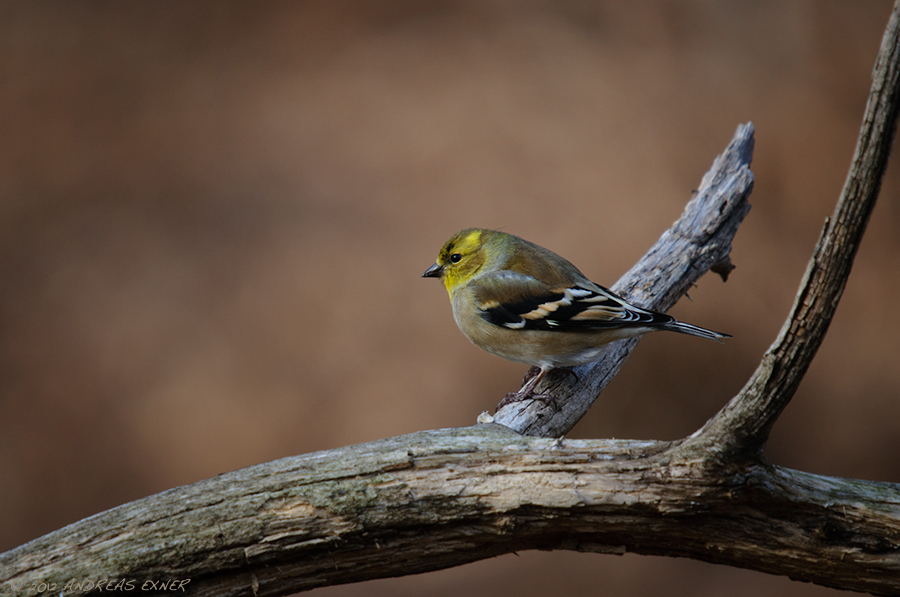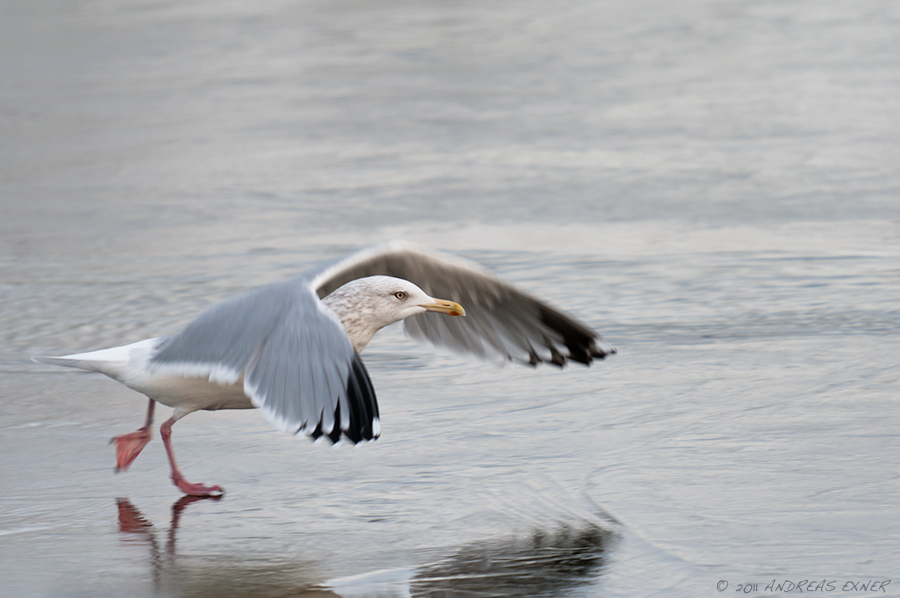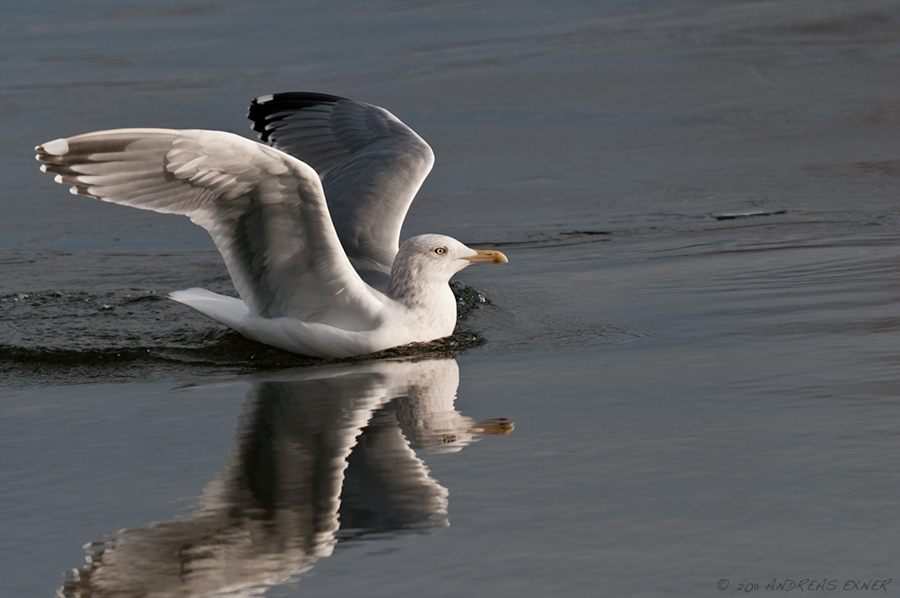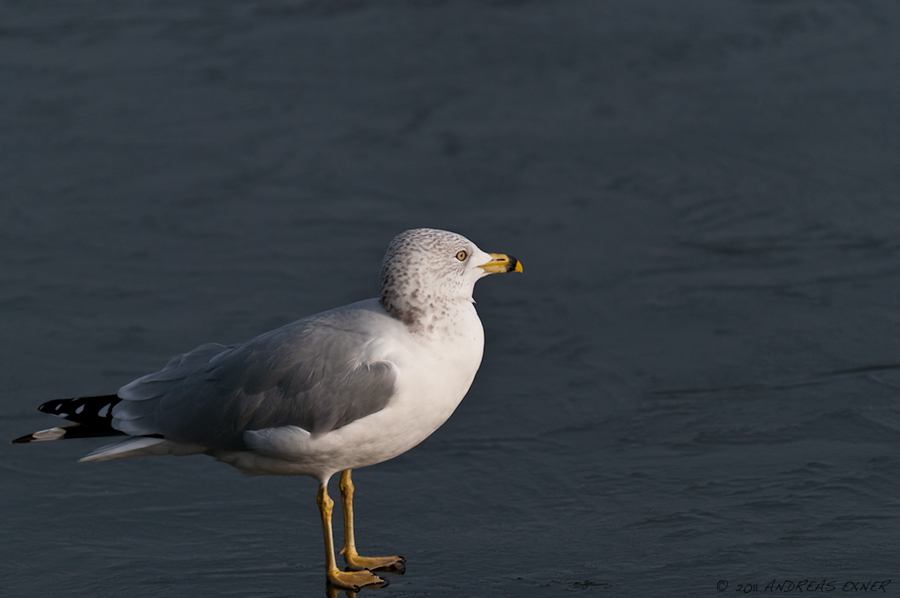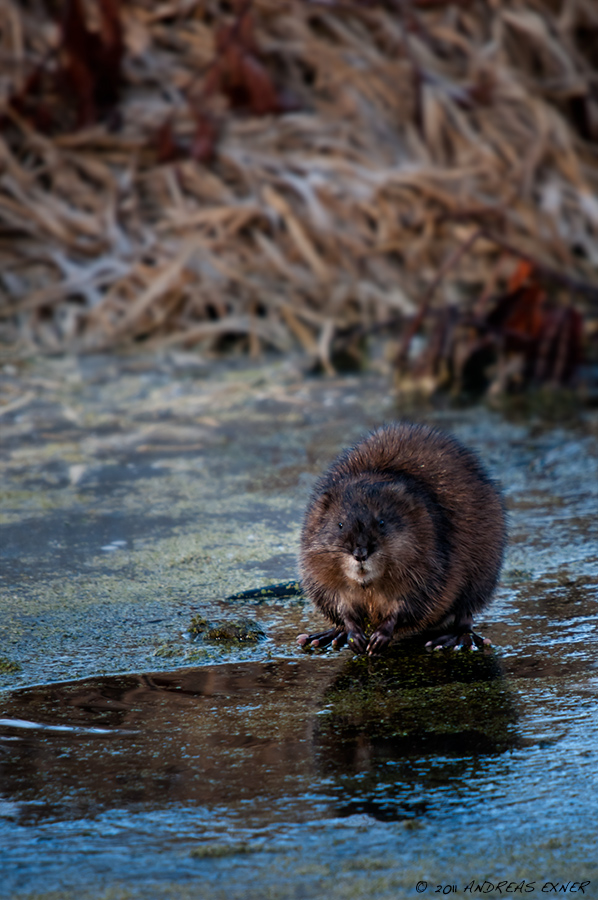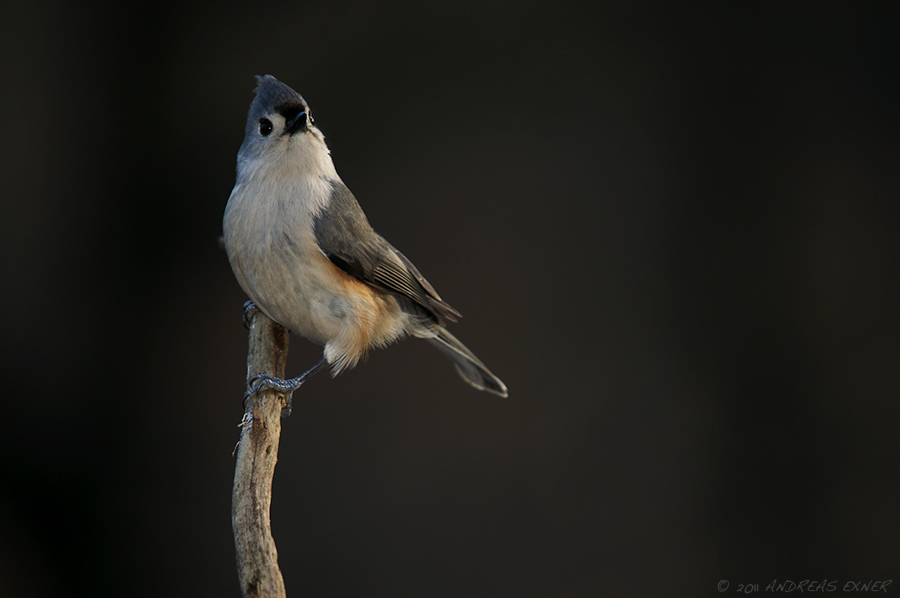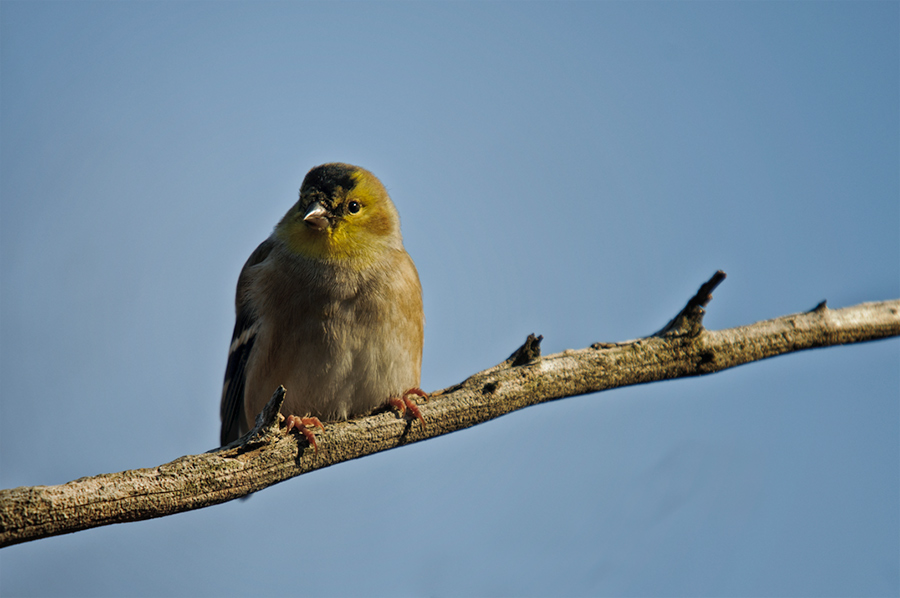Not as planned
Today things didn't really go my way. I had planned to go to Mississippi dam #14 down in Le Claire and was hoping to make some Bald Eagle pictures. I wrote about this already three days ago. All camera batteries were fully charged, the CF-cards formatted, and the gear was ready to be used. As always, I like to be prepared when I go out for any kind of shooting. It wasn't the photo gear that prevented me today from seeing any eagles. After four miles of driving I pulled over into the parking lot of Heritage Pond just north of Dubuque. I wanted to check on some noise coming from one of the front tires. What I found was a little crack that made the tire already bulging. I thought it was too dangerous to continue driving for several hours under those circumstances. After using all the words that are usually beeped out on TV I decided to return home. Better safe than sorry.
Just before I left I saw that a flock of Canada Geese and a couple Mallard Ducks were resting around a spot of open water on the thin ice of the pond. The light was great in quality and quantity. I got the tripod out and made a very slow and careful approach towards the birds. I took about 15 minutes to get as close as possible to the geese without disturbing them. 45 minutes and 490 clicks later a lady jumped out of her car and made the same approach in about 30 seconds!! The geese, of course, turned around and moved further away and the ducks were even flying off. I bet her pictures suck… ;-) What can I say, I guess I made the best out of my dilemma today. I came home with a damaged tire but also with a bunch of wildlife shots, and most important, I had a good time shooting in great light for almost an hour.
Hope for the weekend
Burt Gearhart, a photographer from Le Claire, Iowa sent me a couple great Bald Eagle pictures he made last Monday at the Mississippi River near dam #14. This is good news. These were only his first eagle pictures this season. Because of the warm weather we had this winter so far the eagles stayed up north. I hope I can join him this weekend and have a chance to make a few clicks.
In the meanwhile I'm restructuring my archive, a task I had on my to-do-list for this winter. While going step by step through all my old shooting sessions I rediscover some files that, at least I believe, deserve it to see the light of the day. This one is from February 2010 and was made during my first time shooting Bald Eagles at dam #14 in Le Claire. I look forward to be there again… :-)
Nature clicks #71 - Red-bellied Woodpecker
The Red-bellied Woodpecker is one out of six species of the woodpecker family we have seen here so far around our house. Tall old trees and quite a bit of dead wood around here provide an ideal habitat for the woodpeckers. Especially in the winter they come close to the house and to the feeders but they are very shy. They fly away as soon someone opens a door or a window. With other words, it is hard to make a good picture of them from a close distance.
This picture of this female Red-bellied Woodpecker was made through the glass of our balcony door today. I knew I would have missed this opportunity if I had tried to open the door just even slightly. It may soften the image a little but I don't think the result is too bad. I'm glad I made the click...
Nature clicks #70 - Ring-billed Gulls
As promised I will tell you a little more about my photo shoot last Monday. A little further south from the Green Island Wetlands, on an island in the Mississippi River, lies the town of Sabula, Iowa. There is always a good chance to see some eagles, gulls, geese, or ducks in this area. The water that is not directly effected by the current of the big river was frozen over, despite the still unusual mild weather we have. The ice in the Sabula marina was thin but gave some Ring-billed Gulls a chance to rest and enjoy the warmth of the late afternoon sun. The first photo is my favorite of the three in this post. I was happy to get this shot of the gull during take off. The gulls allowed me to practice my panning technique and they are a great subject because there is always one that is on the move.
Dark clouds moved in and were reflected by the ice, as you can see in the two other images. The low sun, coming already from underneath the clouds, made for absolute killer light. These are the moments I'm looking for, even if I have to wait a whole day. Time well spent in the Great Outdoors….!
Nature clicks #69 - Common Muskrat with gorgeous fur
I had Monday still off from work and used the beautiful weather to check out what's going on in the Green Island Wetlands along the Mississippi at this time of the year. As I wrote often before, this area is my favorite place to study wildlife and make pictures of the animals that live in this habitat or just stop there during migration. We have the mildest winter so far since we live in this area and I was wondering how that may play a role about what animals are present. The first thing I saw, after going through the little village of Green Island and entering the wetland area, was this beautiful Common Muskrat. It was sitting on the thin ice at one of the few open water spots. It was chewing on some greens and used its front legs to get something to eat out of the water. This picture was of course taken before the muskrat went into the water diving for more food and you can really see how beautiful its winter fur looks. And this leads me right to the things I didn't enjoy to see yesterday. It is trapping season and I saw quite a few people checking their traps. Can you blame me if I grinned any time I saw someone returning empty handed to their cars? :-))
I shot from my "mobile blind", which is of course my car. It's not that I'm too lazy to get out of my car but many of the animals don't seem to bother if a car stops nearby. As soon you open the door they take off and your chance for making the image is gone. I usually shut off the engine. This is not only better for the environment, and of course my wallet (I sat in this spot for almost twenty minutes), but it also prevents vibrations coming from the engine being conveyed to the camera. The muskrat was pretty cooperative and stopped chewing once in a while. The pictures became blurry any time I missed the peak of action.
What other animals did I see? Not very many, a couple Bald Eagles, not within shooting range, and a few gulls. After two hours I moved on to Sabula, the little town on an island in the Mississippi. But this is another story for later this week...
My 2011 christmas gift tip: Captured, a book by Moose Peterson
You may ask, why did he put this book out in the hoarfrost? Because I wanted to use the early rays of sun today to shoot this image and just making a snapshot inside the house didn't seem appropriate for this wonderful book. Yes, this is my 2011 Christmas gift tip for those of you who want to take a serious approach to wildlife photography. Maybe grandma is still asking you for another christmas wish or you may find tomorrow a gift card from a book store under the christmas tree.
Why is my book so wrinkled and looks beaten up? Because I got mine at last year's christmas already and I read it and looked at Moose Peterson's images over and over again. He shares his experience from over 30 years of wildlife photography with the reader and you can feel his passion about wildlife photography on every page of this book. Moose Peterson's stories are fascinating and exciting and are told by both, his prose and pictures. Did it make a master out of me? No, not yet, but it helped me to find out in what direction I like to head with my photography and it helped me to deal much better with the technical aspects of wildlife photography. If you don't find it under the christmas tree, go out and get you one, it will be money well spent.
Got the softbox out again
One advantage of working from a home office is that the camera is always on-hand. My D300s is mounted quite often to the tripod with the Sigma 50-500 attached, so I don't waste much time if I see anything interesting outside. We live in a wooded area and there are always at least a few birds around. During my lunch break today I recognized that the birds came more frequently to the bird feeders than during the last few days with their relative mild temperatures. This is usually an indicator that we might get some snow and colder weather. Light was only good for 1/45s at 500mm and the maximum aperture of f/6.3. The birds, mostly chickadee, nuthatch, or tufted titmouse, were moving too fast for a sharp image. And this is when the speedlight-mounted softbox becomes really useful for some fill flash. I wrote about this little DIY-project some time ago HERE. I built this little softbox mainly for my bird photography in the winter. It allows me to shoot 1/250s, even on a day with gray overcast. The other benefit is that the colors turn out more vivid. 1/250s is still too slow to catch all the action, although it is fast enough to capture the birds during the moment when they rests briefly on a branch before take off to the feeders. Usually the chickadees and titmice stop only for about a second. They never become really motionless because the little branches vibrate under the impact of the bird. The light thrown at the bird from the softbox is subtle if you find the right setting at your speedlight. It may take a few shots before you like the results. Another good point for using the speedlight is that it can produce a nice catch light in the bird's eye that is away from the sun.
Nature clicks #68 B - Goldfinch, repeated
Another day with good and relative warm weather and even better light than on Saturday. I wasn't really happy with my Goldfinch pictures yesterday and today was my chance to give it another trial. I made a lot of clicks and experimented with different settings, including flash and softbox. It was just so nice to be outside in the sun and the birds were cooperative as well. :-) For this post I chose an image of a male Goldfinch, sitting on a branch of a dead cedar tree in the warm afternoon sun. No flash was used for this photo.
Nature clicks #68 - American Goldfinch
One bird we enjoy having here all year long is the Eastern Goldfinch, also called American Goldfinch. It is the state bird of Iowa since 1933. They are now in their winter plumage, which makes it sometimes a little harder to distinguish the males from the females. Today was the first day this week with some sunlight coming through the clouds. In addition we had a hint of snow on the ground from last night and that improved the light even a little more. I thought I can try it without the help of a speed light. At ISO 200 exposure was between 1/60 s and 1/90 s and that was not easy to handle with the lens zoomed to 500 mm. The birds jumped around very fast and I really missed getting a tack sharp shot today. Why do I show this photo anyway? Because I like the pose of the goldfinch and the overall light on it. It bothers me that the image is not sharp but tomorrow is another day and I may try it again… Enjoy the rest of your weekend!

